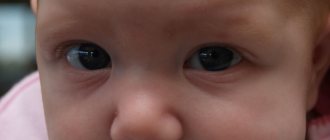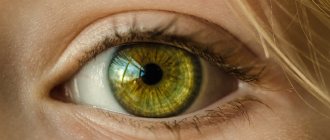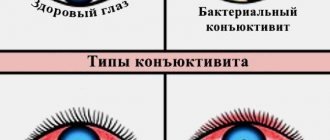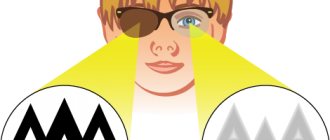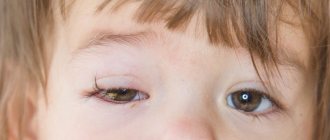Features of treatment at home
In mild cases, conjunctivitis in children can be treated at home, but in compliance with all doctor’s recommendations. If the doctor has prescribed drops and ointments, then they must be used. Traditional methods can only complement drug therapy.
How to properly wash children's eyes
Before using any medications, the child's eyes should be rinsed thoroughly. This must be done correctly, otherwise there is a risk of spreading the infection. Washing is carried out following the following instructions:
- prepare a decoction of chamomile, sage or strong tea leaves;
- the adult who will wash the child’s eyes washes his hands well;
- take a cotton pad, moisten it in a warm broth and wipe the eye from the outer corner to the inner corner. The used disc is thrown away. Wet another one and go through the eye again;
- after one eye is washed, the same manipulation is repeated with the second eye.
After washing the eyes, the adult washes his hands thoroughly with soap. This procedure must be carried out at least 3-4 times a day.
Ointments for conjunctivitis
Various ointments with an antibacterial effect will help to quickly cure conjunctivitis. Children of different ages may be prescribed the following medications:
- Erythromycin ointment. Prescribed for bacterial conjunctivitis. The only contraindications are individual intolerance to the drug.
- Tetracycline. Helps well with inflammation of the mucous membranes of the eyes. After placing the ointment under the eyelid, blurred vision is observed for some time.
- Phloxal. This drug is prescribed even to newborns. Floxal has a detrimental effect on many types of bacteria.
- Tobrex ointment. A broad-spectrum antibiotic that can be prescribed to children older than 2 months.
- Colbiocin. This combination drug helps even with severe forms of conjunctivitis. It is not prescribed to children under 8 years of age.
- Eubetal. This drug has antibacterial and antiallergic effects.
Antibacterial ointments can be used according to doctor's instructions. It is recommended to undergo a bacterial culture test in order to accurately determine the cause of the inflammation.
The duration of treatment with ointments should be at least 5-7 days, otherwise there will be no effect from the therapy.
Baby drops
To treat conjunctivitis in children at home, you can use various drops
If necessary, you can start using them without first consulting a doctor, which is especially important if the illness occurred on a weekend or holiday. Before use, please read the instructions carefully
- Levomycetin. A common drug for the treatment of inflammatory eye diseases. At the initial stage of the disease, it is recommended to drip the drug every 2-3 hours.
- Tobrex. Such drops have a pronounced antibacterial effect.
- Phloxal. This drug can be prescribed even to newborn children. Helps cure inflammation of the eye mucosa in a relatively short time.
- Oftalmoferon. This drug helps to quickly eliminate unpleasant symptoms.
Levomycetin is considered the cheapest of the drugs presented, but do not underestimate it. This drug can eliminate the disease in a few days.
Reduced insolation
You should not suddenly stop dripping and smearing your eyes if the mucous membrane of the eyes is inflamed. This can lead to re-exacerbation and development of superinfection.
The number of procedures is reduced gradually. If at the beginning the eyes are dripped every 2-3 hours, then after 3-4 days the procedures are carried out three times a day. Then the medicine is dripped twice a day for a couple of days and then just stopped.
How to properly wash your eyes for conjunctivitis
There are several ways to wash your eyes with conjunctivitis:
- The prepared medicinal solution is filtered in order to avoid foreign bodies getting into the eyes . Then it is poured into a clean container, put into a pipette and instilled behind the lower eyelid. It is not recommended to use this method on your own; the procedure must first be agreed upon with an ophthalmologist, and it is he who must prescribe the product used to wash the eyes.
- This method is suitable if the child is already old enough and you can come to an agreement with him. Most often, this type of washing is used to wash the eyes when a foreign body enters. For the procedure, use clean, warm boiled water, which is poured into a thoroughly washed container and doused with boiling water. The child should be asked to immerse his face in the water, open his eyes and blink.
- The most common and safe method that allows you to eliminate crusts and pus that have accumulated in the eyelash area. For washing, use a container with a medicinal solution and a piece of gauze. They need to be wetted, lightly squeezed and gently wiped from the outer edge of the eye to the inner one. The swab must be re-wetted until the eye is completely clean. For the other eye, you need to use a different gauze pad. If conjunctivitis affects only one eye, the rinsing procedure should begin with the healthy one. After washing, the spent solution is poured out, and the container is thoroughly washed, doused with boiling water and dried in order to be reused.
If a large amount of medicine has been prepared and can be stored for a certain period of time, then the medicine is gradually poured into a container for washing, heated a little and used.
Drug treatment
Drug treatment mostly consists of the use of eye drops and ointments. Today, there are a huge number of medications against conjunctivitis, but your doctor will be able to determine which one is right for you personally based on the test results.
Allergic form
Characterized by rapid development of the process. The cause of the pathology is the body’s increased sensitivity to some substance. The most common allergens are food, pollen, dust, and animal hair. Children experience itching, redness, and watery eyes.
Treatment of allergic conjunctivitis is selected taking into account the mechanism of development of the process. The primary goal is to detect the antigen and avoid contact with it. You should also be concerned about immediately taking antihistamine drugs, which relieve the symptoms of sensitization, that is, a violent reaction of the body.
IMPORTANT! For mild forms of allergic conjunctivitis, local use of antihistamines is sufficient.
In severe cases, specialists resort to hormonal drugs
Particular attention is paid to strengthening the immune forces of the growing organism. Therapeutic treatment regimens are prescribed taking into account the age of the young patient, the characteristics of the course of the pathology and the form of inflammation
The classic treatment regimen for allergic conjunctivitis is as follows:
- cold compresses. The procedure is repeated three times a day for fifteen minutes. For a one-month-old baby, it is better to carry out the manipulation during sleep;
- antihistamine drops (Opatanol, Cromoglin);
- antihistamine syrups and tablets;
- artificial tear preparations are prescribed for chronic conjunctivitis accompanied by dry cornea;
- drops with vitamins will help restore damage to the cornea;
- hormonal drops and ointments help relieve the inflammatory reaction;
- local antibacterial therapy for bacterial infection.
Contact of the child’s body with the allergen should be avoided.
Bacterial variant
Characterized by rapid development. Already within the first day after exposure to the infectious agent, pronounced clinical symptoms are present. The disease is difficult to treat, and treatment with folk remedies produces virtually no results. For a complete cure, you usually have to use antibiotics in the form of drops and ointments for a long period of time. In severe cases, systemic antibiotic therapy is indicated.
The following drugs are used in pediatric practice:
- Fucithalmic. Even a 2-month-old baby can use the drops. Doctors prescribe one drop twice a day for one week;
- Albucid. These are inexpensive drops that can be used to treat a 4-month-old child. Drops should be instilled five times a day;
- Vitabact. Treatment therapy lasts about ten days. Depending on the severity of the pathological process, the drug is used from two to six times a day;
- Levomycetin. Drops are suitable for children from 2 years of age.
Viral type
The viral type in most cases occurs as a consequence of a respiratory disease, which has a negative impact on the immune system of the child’s body. The process may be accompanied by a sore throat, nasal discharge, and an increase in body temperature.
Oftalmoferon is very popular in the treatment of viral conjunctivitis. This is a combination product that contains immune components. The drops have not only antiviral, but also antihistamine effects.
Another good remedy is Oftan Idu, which is usually prescribed for advanced stages of the pathological process. It should be dripped every hour during the daytime for three weeks. Oftan Ida is prescribed to children from two years of age.
Teach children good hygiene from a very early age. After a walk, before eating and performing medical activities, you should thoroughly wash your hands with soap. Make sure your child does not rub his eyes with dirty hands. Cut his nails regularly.
Preparation of furatsilin solution for washing the baby's eyes
Furacilin is most available in tablet form. Therefore, just take one tablet of furatsilin and dissolve it in half a glass of boiled water. Then strain so that undissolved tablet crystals do not get on the baby’s mucous membrane. Use only freshly prepared solution.
Furacilin tablet does not dissolve well in water, so before putting it in water, crush it into powder, then pour boiling water over it and let it cool.
After washing the eye, a 0.25% solution of chloramphenicol is useful. To do this, pull the baby's lower eyelid down and drop 1-2 drops of the solution.
If purulent discharge does not go away, get tested - smears to determine flora and sensitivity, and contact. He must make a diagnosis and prescribe appropriate treatment.
A very common eye disease in children is conjunctivitis. This is due to the lack of maturity of the body’s defense system in children, as well as severe eye strain in schoolchildren. In addition, infectious variants of the disease are easily transmitted among children. With conjunctivitis, purulent or mucous discharge from the eyes often occurs. Therefore, treatment of the disease cannot be done without rinsing. The question arises, what can you use to wash your eyes with conjunctivitis in children?
To avoid discomfort with conjunctivitis and prevent complications, you should follow preventive measures for this disease in children:
- Prevent the baby from hypothermia, prevent the spread of acute respiratory viral infections and influenza, for example, participate in seasonal vaccinations.
- Monitor the cleanliness of the nursery, especially with regard to bedding and bath items and toys.
- Organize a proper, nutritious diet.
- Use air purifiers and humidifiers in children's rooms and regularly ventilate the premises.
- Support immunity with vitamin and mineral complexes.
- Control visual stress and lighting.
The symptoms of the disease in children are similar to the signs of the same disease in adults. But children, especially preschool children, react to inflammation of the conjunctiva more violently: they begin to be capricious, do not want to eat, become restless or, conversely, excessively lethargic.
The main symptoms of the disease are:
- redness of the mucous membrane of the eyes, swelling of the eyelids;
- painful reaction to bright light;
- excessive lacrimation or, conversely, dry eye syndrome;
- decreased vigilance;
- burning, stinging, feeling of sand or a foreign object in the eyes.
Conjunctivitis can be of different nature depending on the type of pathogen. With a bacterial infection, the eyes fester, become crusty, and are difficult to open in the morning. With a viral infection, the main symptoms are present, but there is no pus, the discharge is whitish, mucous. With allergies, there is also no pus, but both eyes are affected at once. The combination of pharyngitis and conjunctivitis indicates the adenoviral nature of the latter.
Treatment of children for this disease can only be under the supervision of an ophthalmologist, since serious complications are possible, and it is problematic to independently determine the type of pathogen. However, you can also rinse your eyes in the morning, before visiting the doctor, as first aid. To do this, use a weak solution of furatsilin or chamomile infusion. The procedure is carried out by moving a cotton swab soaked in the product from the temple to the nose. The resulting crusts are removed with a cotton pad soaked in the same solution.
If one eye is affected, the child should rinse both of them, because the infection can easily spread to the second. An individual cotton swab is used for each eye.
Symptoms depending on the type of conjunctivitis
There are several forms of conjunctivitis in children 3 years old. Each of them is characterized by certain clinical symptoms.
The following characteristics are determined for the bacterial form:
- severe redness of the eyes;
- sensation of a foreign body under the eyelid that is not actually there;
- increased dryness of the mucous membrane, even despite the release of pus, which leads to damage to the cornea;
- purulent discharge that sticks the eyelashes together in the morning; they can be of various colors - from yellow to dark brown;
- discomfort in the form of pain, burning, itching in the eyes;
- If left untreated, the infection moves to the eyelids, cornea, and lacrimal sac.
The symptoms of viral conjunctivitis are slightly different:
- severe photophobia;
- complete absence of purulent discharge, they can only be serous, without color and in small quantities;
- severe swelling of the eyelids, often the eyes cannot be seen behind them;
- increased body temperature;
- symptoms of malaise in the form of weakness, fatigue, drowsiness, chills;
- spasm of the eyelids, which most often occurs when exposed to bright light; a person cannot open the eyelids;
- the formation of bubbles on the mucous membrane, filled with transparent contents, is possible; this phenomenon occurs during herpes infection.
There is an allergic form, which is determined by the following clinical symptoms:
- severe redness of the eyes, patients sometimes think that there is a hemorrhage in the cornea, but in fact this phenomenon is due to the fact that the vessels dilate and inflammatory mediators come out into the eyes, forming an immune reaction;
- acute sensation of itching, burning, pain in the eyes;
- increased lacrimation, which with prolonged allergic conjunctivitis is replaced by dry eyes;
- the possibility of the formation of a discharge from the inner corner of the organ of vision, which has a transparent color, it is very small;
- rhinitis, that is, the formation of mucous discharge from the nose, which appears due to the action of an antigenic substance on the mucous membrane.
These are the main forms of conjunctivitis, which are most common in children.
How to wash a child’s eyes if there is pus. Causes and treatment of eye suppuration in a child
It is important to know that the spread of infection in children occurs very quickly and rapidly.
By purulent eyes in children we mean the presence of mucous discharge from the eyes that is yellow or yellow-green in color.
Symptoms of conjunctivitis in a child
In addition to eye discharge, other symptoms appear, which include:
• dried purulent crusts on the eyelids and eyelashes • redness of the eyes • lacrimation • swelling of the eyelids
Causes of purulent discharge from the eyes in children
Eye diseases that can cause purulent discharge from the eyes in newborns and infants:
Dacryocystitis of newborns
Many children are born with poorly developed tear ducts. This means that tears cannot drain properly into the nasal cavity. Because of this, secretions from the eyes accumulate in the lacrimal sac and inflammation begins. In this case, as a rule, only one eye of the baby becomes watery and purulent.
Treatment in the first 3 months of the child is carried out with medication. Anti-inflammatory drops are instilled and massage of the lacrimal sac is applied. In most cases, dacryocystitis goes away. Sometimes it is necessary to probe the lacrimal ducts.
Neonatal conjunctivitis
Inflammation of the mucous membrane of the eye during the period 28 days after birth is called neonatal conjunctivitis.
Bacteria that cause inflammation: Staphylococcus aureus, chlamydia, streptococcus, etc.
Gonococcal infection of newborns
With gonococcal infection, newborns have very profuse purulent discharge, with pronounced swelling of the eyelids. Damage to the cornea and development of corneal ulcers may occur.
Eye injury during childbirth
In case of pathological birth, eye damage and infection of the eye are possible.
Inadequate eye care immediately after birth
Immediately after birth, newborns are given special antiseptic drops for prevention. In the case when drops are not used, the risk of developing conjunctivitis in newborns is increased.
Inflammation of the mother's genital tract
Inflammation of the mother's genital tract leads to infection of the child and the appearance of signs of eye inflammation.
Causes of purulent discharge from the eyes in pregnant women and children over one year old
ARVI and influenza
Pus that may be present in your child's eyes may be due to a viral infection. Knowing the causative factors, as well as how to cope with them, can prevent the development of purulent discharge from the eyes in an infant.
Sinusitis
If your baby has a cold, he may develop sinusitis (inflammation of the sinuses). Important symptoms: fever, pain in the forehead and eyes, lacrimation and suppuration of the eyes.
Allergy
If your baby has a runny nose and you notice redness and small mucous-yellow discharge, then it may be an allergy.
Conjunctivitis
The eyes of children and pregnant women often fester due to infectious inflammation. Inflammation can be caused by both bacteria and viruses. Symptoms of conjunctivitis begin in one eye and then spread to the other eye.
Eye festering during pregnancy
In a pregnant woman, due to hormonal changes, the conjunctiva becomes loose and there is more mucous discharge from the eyes. This may cause some discomfort when wearing contact lenses.
If you are pregnant and wear contact lenses, be aware of discharge from your eyes. If yellow discharge occurs, remove your lenses and consult a doctor.
A child's eye is festering, treatment
Situations that require immediate attention and medical attention include the following symptoms:
• severe swelling of the eyelids and very profuse purulent discharge • increased body temperature • the child complains of decreased vision and pain in the eyes • the child rubs the eye • redness of the eyes and watery eyes
It is important to know that the spread of infection in children occurs very quickly and rapidly. Therefore, it is necessary to seek medical help in a timely manner.
During treatment, when using eye ointments and drops, it is necessary to first remove pus from the eye. Any types of medications (drops and ointments) are effective only after rinsing the eye.
Come for diagnostics at the address: Almaty, Tole bi street, 95a (corner of Baitursynov street).
Telephone;
All important information about coronavirus in Kazakhstan is published in the telegram channel “zakon.kz”. Subscribe!
Symptoms
The general clinical picture is determined depending on the nature of the development of a particular disease. That is why it is customary to differentiate the signs. In addition, the degree of development of the disease, its neglect, as well as the individual characteristics of the child are of significant importance. Let's consider all the key points and relate them to the nature of the disease.
Allergic
First of all, it is worth considering the characteristic signs of allergic conjunctivitis.
- The main symptom is redness of the whites of the eyes;
- The baby may complain of eye pain and discomfort;
- The eyelids swell greatly;
- Eyes and eyelids begin to itch;
- There may be small discharge, transparent, viscous.
If you suspect that your child has allergic conjunctivitis, you can immediately give him the usual allergy pills and drops. This is true if you have already treated your baby for allergies, he was examined earlier and prescribed appropriate allergy medications.
Remember that it is prohibited to carry out treatment or purchase medications on your own. You can harm the baby in this way.
Viral
Conjunctivitis is often viral in nature. The main pathogens here are herpes and adenoviruses. Here are the most common signs:
- There is discharge, but scanty, without pus;
- Small follicles may form, as well as films in the area around the eyes;
- There are unpleasant sensations in the eyes, cutting pain;
- Body temperature rises;
- There may be a fear of light;
- The conjunctiva becomes inflamed;
- The whites of the eyes turn red and the blood vessels in them burst.
Be careful, always pay attention to the slightest nuances and carefully monitor the child’s condition
Viral conjunctivitis is very important to start treating at an early stage, as it can cause a variety of complications
Bacterial
It is known that in most cases it is pyogenic bacteria that provoke the development of bacterial conjunctivitis. Here's what the symptoms might be.
- There is active discharge of pus. It may have a yellowish or grayish tint. At the same time, the consistency is quite viscous;
- During sleep, eyelashes and eyelids even become firmly stuck together due to the abundant secretion of pus;
- There is a feeling as if there is a foreign object in the eye. The child will rub his eyes, try to remove the apparent object that is bothering him;
- The skin around the eyes, as well as the mucous membranes themselves, dry out. Corresponding irritation appears, the eyes itch;
- The eyelids and eyes become significantly red;
- Blood vessels may burst in the eyes;
- Swelling is observed. It gets worse if the child frequently rubs his eyes;
- There are also strong pain sensations.
Unfortunately, pathogenic agents can spread. In such cases, damage is observed not only to the conjunctiva, but also to the cornea. Bacterial disease is quite dangerous
It is very important to identify the signs as early as possible, begin treatment in a timely manner, and send the child for examination.
Treatment at home
Almost all diseases related to the organ of vision are only diagnosed in hospitals, and further treatment itself occurs at home. Cases of hospitalization are very rare.
Is it possible to cure conjunctivitis at home?
As a rule, treating conjunctival lesions at home in children is not acceptable or correct. But an adult body is able to cope with such an illness easier and faster.
For allergic or viral conjunctivitis, various lotions from herbs and decoctions are used, which are quite effective. For children, it is best to consult a doctor immediately to avoid improper care and treatment, which can cause dangerous consequences.
Drops and ointments from the pharmacy
Currently, in the pharmacies of our vast country you can purchase a variety of medicines for the treatment of conjunctivitis. All excipients of these drugs have antiseptic and anti-inflammatory properties.
Folk remedies
Various herbs are often used to treat conjunctivitis. These can be infusions of chamomile, cornflower, sage, and calendula. Black and green tea also have good anti-inflammatory properties. Aloe juice is no less effective in treating conjunctivitis.
Dill, bay leaves, and fennel seeds also serve as an auxiliary remedy in the fight against conjunctivitis. All these products also have an antiseptic that helps relieve swelling and eliminate redness.
Bacterial conjunctivitis cannot be cured with infusions and lotions based on various herbs alone, since these remedies can only remove the symptoms themselves and not kill the bacteria. Therefore, this form of the disease is treated in combination with broad-spectrum antibiotics.
Lotions
Warm herbal tea compresses perfectly help with such eye lesions and are not contraindicated for pregnant women and children; they are absolutely harmless and safe.
Tea recipe. Take chamomile, calendula and dill. Regular tea is brewed. You should also add a pinch of sea salt to your tea. It is recommended to boil the broth well to avoid various types of infections. Under no circumstances should chamomile or calendula be used if the patient is allergic to these herbs.
Alternating cold and warm compresses helps a lot; it significantly reduces the pain and also helps you not feel it. Use a different cotton swab for each eye, as using one can also lead to infection.
Conjunctivitis can also be effectively treated with aloe vera extract. Juice and purified water are taken, all this is diluted 1 to 10 and lotions are made.
An infusion of the following herbs helps greatly: toadflax grass (2 tablespoons), blue cornflower flowers (2 tablespoons), elderberry flowers (2 tablespoons). All this is poured into two glasses of boiling water, infused for 8 hours and filtered - the decoction for lotions is ready. It is also effective in improving and enhancing vision.
To relieve eye inflammation, an alcohol tincture of dope seeds is also used. Crushed seeds and alcohol (70%) are infused for a week in a ratio of 1 to 5. Half a teaspoon of tincture is diluted with half a glass of water and lotions are made.
Calendula vulgare inflorescences will also effectively help in the treatment of conjunctivitis. To do this, dilute 1 teaspoon of calendula tincture (25%) in one glass of water. Lotions are made from the resulting liquid.
Plantain seeds are no exception; they are also effective in combating disease. 2 teaspoons of crushed seeds are poured into 2 teaspoons of water, then shaken. Then 6 tablespoons of boiling water are added, the whole thing is shaken, cooled and filtered. Lotions from this decoction are also excellent for relieving inflammation of the mucous membranes.
Healthy eyes and good vision are an integral part of a full human life.
Therefore, it is very important to monitor and take care of your health, including the health of your eyes.
Eye wash solutions
Conjunctivitis is characterized by copious purulent discharge, so in the morning it is difficult for children suffering from this disease to open their eyes. Because they stick together overnight. Therefore, to remove dried discharge from eyelashes and inner corners of the eyes, various solutions are used.
The most commonly used solution is "Furacilin". It has antiseptic properties and promotes the new formation of pathogenic bacteria. Also, this drug is harmless for both adults and children.
What solutions and infusions are suitable for children
You should not experiment with rinsing agents so as not to harm the child. It is necessary to strictly follow the recommendations of an ophthalmologist, who will take into account all the risks of allergic reactions and intolerance to a particular drug, as well as the age of the baby.
Usually, if conjunctivitis is of an allergic nature, rinsing is not necessary: taking antihistamines and eliminating the irritant is enough. In addition to Furacilin, the doctor may prescribe Albucid among medications. In the form of a ten percent solution, it is suitable even for infants. For older children, it is possible to use such agents as Levomycetin, Vitabact, Fucithalmic, and others.
Folk remedies, as well as infusions of medicinal herbs, are also used for washing. This should also be done after consulting a doctor to avoid unwanted reactions.
At home, wipe your eyes with the following non-medicinal means:
- A weak solution of table salt or baking soda.
- Infusion of calendula or chamomile. In the first case, you need to take two large spoons of flowers per cup of boiling water, in the second - three. Filter the infusion after cooling.
- Aloe infusion or juice. To prepare the first remedy, four leaves are soaked in warm water for several hours. Freshly squeezed juice for rinsing should be diluted with water in a ratio of 1:10.
- Infusion of marshmallow root. The crushed plant material is infused in warm water for seven hours.
- Tincture of rose petals. A handful of rose petals are infused for 30 minutes in cool water.
- Freshly brewed black and green tea without flavorings or dyes.
- Infusion based on bay leaf. To prepare it, you will need three leaves, which are steamed in hot water (a glass) for about half an hour.
- Dill juice. Squeeze the juice from fresh dill stems and dilute it half and half with water (pure juice can be used for compresses).
- Blueberry tea. Dried berries are poured with boiling water and left for 30 minutes. You can, if the child does not have allergies, add a little honey to enhance the antiseptic effect.
It is not necessary to choose only one option: infusions can be alternated. Do not forget to properly filter the finished composition so that small particles do not get into your eyes and injure them.
Before washing procedures, it is very important to know for sure that the baby has conjunctivitis. Indeed, for other ailments, for example, inflammation of the iris - iritis - such manipulations are contraindicated.
The body of a newborn is vulnerable to various external influences. Therefore, it is important to pay attention to hygiene and proper care. A baby's delicate eyes require special care and attention. In addition, sometimes young parents have to deal with the problem of suppuration and inflammation of the eyes of their newborn babies. We will tell you in this article how and with what to wipe a newborn’s eyes.
Treatment of conjunctivitis in children at home
Timely elimination of the symptoms of conjunctivitis is an important factor that will eliminate the occurrence of various complications. Conjunctivitis in children, treatment at home which requires prior consultation with an ophthalmologist, usually resolves within 5-7 days
To speed up your baby’s recovery, it is important to follow the following rules:
When the first signs of disease occur, the child’s eyes must be washed with a solution of furatsilin or chamomile decoction every three hours. Purulent crusts are carefully removed with cotton pads soaked in a decoction of medicinal herbs or a disinfectant solution. It should be remembered that a separate cotton pad should be used for each eye. If a child has one eye inflamed, the second one should also be washed, since the disease tends to quickly spread to the healthy mucous membrane. In the presence of an inflammatory process, bandages and lotions should not be used, as they provoke the proliferation of pathogenic microorganisms and can damage the diseased eyelids. It is necessary to treat conjunctivitis only with those medications and eye drops prescribed to the child by an ophthalmologist.
The drops are carefully placed in the baby's eye, and the ointments are carefully placed under the lower eyelid.
Medical solutions for washing eyes in children
To wash the eyes of children with conjunctivitis, use the following solutions:
- Furacilin . To prepare it, you need to take 1 tablet of Furacilin per 100 ml of water. Boil water over low heat, add the crushed tablet and leave until completely dissolved. After this, the solution is brought to the initial volume with boiled water. Then the product is filtered and the affected eye is wiped with sterile gauze. When rinsing both eyes, you must use separate wipes. The finished product can be stored in a cool place for no more than a day. You can purchase a ready-made sterile solution of Furacilin at the pharmacy. More information about washing eyes with furatsilin can be found here.
- Potassium permanganate . Solution concentration 1:5000. In order to prepare it at home, you need to dilute a small amount of potassium permanganate in boiled chilled water. Then the resulting solution is added drop by drop to water for washing the eyes; its shade should be pale pink. The finished product cannot be stored; it is used immediately.
- Sodium chloride solution (saline). It is not recommended to prepare an eye wash at home; it is better to purchase it at a pharmacy. Its cost is very affordable, and unlike other products it does not cause allergies or irritation. It can be used for mechanical cleaning or removing debris. For conjunctivitis of bacterial or viral origin, the product will not give the desired effect, so it is used in combination with eye drops.
General principles
An ophthalmologist treats conjunctivitis in children. The method of therapy is selected taking into account the type of disease. Acute eye inflammations usually respond well to treatment even at home. However, there is always a risk of complications when carrying out incorrectly selected therapy. That is why independent attempts to get rid of the disease are unacceptable.
The first rule for treating childhood conjunctivitis is to constantly wash the eye. Crusts form on the surface of the organs of vision, which can be softened with chamomile decoction or furatsilin solution. Chamomile flowers are known for their bactericidal properties. The use of a medicinal plant will prevent further infection of the visual system.
IMPORTANT! Even if only one eye is affected by conjunctivitis, treatment procedures should be carried out on both organs of vision, since the infection is quickly transmitted.
To avoid infection, use cotton swabs and swabs for each eye separately. The drops should be used strictly according to the regimen prescribed by the doctor. There is no need to exceed the dosage in order to speed up recovery. This way you can only harm yourself by causing overdose symptoms. It is worth understanding that the conjunctival sac in any case cannot accommodate more than two drops. Never cover your eyes with a blindfold. This will prevent the drainage of pus and tears.
To avoid injury, it is best to use a pipette with a rounded end to install drops into the eye sac. If an infant falls ill, a relative should help you and gently hold the baby's head. Do not drop the product into the center of the eye. It is better to gently pull down the lower eyelid and inject the drug into the conjunctival cavity.
The pipette should not touch the eyelids and eyelashes. Before installing the drops, the pathological secretion should be removed. If you have constant watery eyes, you need to apply eye drops every hour. To avoid pain, the bottle with the medicinal solution should be warmed in your hand before use.
It is imperative to contact a specialist in the following cases:
- the infant fell ill;
- there is no dynamics of treatment for several days;
- bubbles appeared on the eyelids;
- it hurts the child to look at the light source;
- there was pain;
- the quality of vision has deteriorated.
ATTENTION! If the baby resists and closes his eyes tightly, drop the product between the eyelids; the medicinal solution will still get on the mucous membrane. It is possible to answer the question of how many days it takes to treat conjunctivitis in children only after undergoing diagnostics
Therapy for viral infection lasts from five to twenty days. This largely depends on the individual characteristics of the baby and the state of his immune system.
It is possible to answer the question of how many days it takes to treat conjunctivitis in children only after undergoing diagnostics. Therapy for viral infection lasts from five to twenty days. This largely depends on the individual characteristics of the baby and the state of his immune system.
For example, adenoviral conjunctivitis is mild and lasts no more than one week. But the herpetic variant is characterized by a severe course and long-term treatment. The bacterial nature of the inflammation lasts more than one week and does not go away on its own. This type of conjunctivitis requires the use of antibiotics and strict supervision by a specialist. Allergic pathology can last for many years. Upon contact with an allergen, the disease worsens, and when the provoking factor is eliminated, a period of remission begins.
Treatment of conjunctivitis at home consists of the integrated use of traditional and folk remedies. Experts recommend choosing medicinal plants that have anti-inflammatory, antibacterial, healing and hypoallergenic properties. The following herbs will be of great benefit for conjunctivitis in children:
- aloe,
- sage,
- rose hip,
- chamomile,
- St. John's wort,
- cornflower,
- violet,
- thyme,
- celandine.
During installation, ask your child to look up


